SOUPING UP THE SPIDER
by Gregg Chamberlain

SOUPING UP THE SPIDER
by Gregg Chamberlain

|
|
|
|
|
|
|
|
|
|
|
|
An encounter with spiders
is an almost
universal quality in fantasy
tales and
dungeon
adventures — usually with the
spiders getting the worst
of it. In the eyes
of many FRP gamers, spiders
are among
the weakest of monsters,
best relegated
to early-encounter challenges
for a
group of new dungeon-delvers.
But nature has endowed spiders
with
many distinctive attributes,
and the skill-
ful USE of some of the more
obscure
types of spiders as monsters
can provide
challenging and entertaining
encounters
for expert as well as novice
characters.
Ugh, a spider!
Spider
biology
First, a little background
information:
Spiders belong to the phylum
Arthropoda, class Arachnida, order Araneae. They
differ from insects in having
eight legs
and a body composed of two
parts, the
cephalothorax and the abdomen.
To the
cephalothorax are joined
the legs; the
pedipalps, which cut and
crush the spi-
der’s food, making it easier
to digest; and
the chelicerae, or fangs,
which the spi-
der uses to seize her prey
and inject ven-
om into it. The abdomen
contains the
heart and lungs of the spider
as well as
the silk glands and spinnerets
the spider
uses to spin her webbing.
Most spiders encountered
by players
will be female, unless otherwise
stated
by the DM, since male spiders
do not, with only a few exceptions,
live past the mating period.
Spiders depend primarily
on their high-
ly developed sense of touch
for informa-
tion about prey, mates,
and possible
enemies. The legs and the
pedipalps de-
tect vibrations in the web
(in the case of
weaver spiders), to indicate
something
has blundered into the web.
Also, tiny hairs all over
the body of a
spider contain nerves that
are sensitive
to changes in air pressure
as well as cer-
tain chemical odors. It
is not very easy <surprise bonus, or, use the DSG odor
rules, giving spiders the Scent
ability>
for adventurers to sneak
up on a spider.
Just as a fly can sense
disturbances in
the air when a person tries
to swat it, so a
spider in a dungeon can
tell when a door
has opened and/or closed,
and when
someone has’ entered a room,
by air-
pressure changes and the
person’s body
odors.
Hunting
spiders also can detect vibra-
tions, changes in air pressure,
and chem-
ical odors. But they rely
more on sight
for finding and catching
prey, as well as
for fighting or avoiding
enemies. Nearly
all spiders have six eyes,
two large and
four small, spaced along
the front and
sides of the cephalothorax.
Hunting spi-
ders, such as the tarantula
and the wolf
spider, have very good eyesight.
(The
wolf spider may even possess
a rudimen-
tary sense of smell.) One
exception to
the above statement is the
jumping spi-
der, which has four large
eyes that give
her the keen eyesight she
needs to accu-
rately judge the distance
to her prey.
The what
and why of webs
Spiders use webbing for
building
nests, capturing prey, and
making co-
coons for the young to hatch
in. The
major drawback of webbing
in the dun-
geon is that it burns too
easily, becoming
a death trap for the spider.
Webbing, or web silk, comes
from web
glands located in the spider’s
abdomen.
It is similar in composition
to the silk
produced by silkworms and
used to
make fabric. Weaver spiders
have from
four to five different web
glands to pro-
duce the silk they need.
Hunters, who
chase their prey, have two
or three dif-
ferent glands.
The liquid silk is excreted
through the
spinnerets located just
under the rear of
the abdomen. Usually the
silk hardens
almost as soon as the air
hits it, and is
then stretched, pulled,
and combed to
form it for a particular
use.
The web glands make several
types of
silk, depending on what
the web is to be
used for. Webbing can be
sticky, smooth,
and even multi-colored.
It can be used
for trapping victims, as
cable (the drag-
line spiders hang from),
for making co-
coons — and there’s even
a light web-
bing that spiderlings use
for ballooning.
Weaver spiders use a combination
of
sticky and non-sticky silk
when con-
structing their webs. Non-sticky
silk is
used for the basic framework
of the web,
while the sticky variety
is used in the
spiral pattern that traps
prey.
Web silk is, in proportion
to its size,
one of the lightest, strongest
fabrics
known. Arachnologists (those
who study
spiders) estimate that a
cord of spider
silk half an inch thick,
or perhaps thinner,
could hold a strong man
prisoner easily.
A rope made of spider silk
would be in-
valuable on a dungeon expedition
where
keeping weight and bulk
to a minimum
are essential. And adventurers
could
profit from selling spider
silk to weavers.
Spiders can also shoot webbing
at
enemies behind them. According
to one
source, “Silk may be squirted
as far as an
inch from the spinnerets
(normal garden
spider), a distance sufficient
to make
combat safe.” (“Spider”,
Encyclopedia
Britannica, Vol.
21, 1971, page 20.) For a
spider the size of the large
spider as de-
scribed in the AD&D™
rules, this would
translate to a distance
of about 5-6 feet,
increasing to 10-12 feet
for a huge spider
and 20-25 feet for a giant
spider.
Targeting for such a shot
would be
accomplished through a combination
of
the two small eyes furthest
along the ce-
phalothorax and the abdominal
hairs
that sense pressure changes
and the
body odors of the person
or creature ap-
proaching from the spider’s
rear. Since
the web glands control the
consistency
of the web fluid, the silk
squirted may
come out as a sticky blob
from 6-12
inches in diameter (depending
on the
size of the spider), or
possibly as a sticky
cable. The blob would either
blind the
opponent temporarily (3-5
rounds to
wipe the eyes clear) or
“gum up” the
opponent’s hands and arms
(penalty of
from -1 to -3 on attack
and defense, de-
pending on the size of the
spider, for the
same 3-5 rounds). A special
oil secreted
by glands in the spider’s
body keeps her
from sticking to her own
webbing.
Weavers: Barrel Spider, Boleadore Spider, Net-Throwing & Fishing Spider.
Boleadore Spider <no wiki> <video>
FREQUENCY: Rare
NO. APPEARING: 1-4
ARMOR CLASS: 4
MOVE: 3"*12"
HIT DICE: 4+4
% IN LAIR: 70%
TREASURE TYPE: [C]
NO. OF ATTACKS: 1/1
DAMAGE/ATTACK: 2-8
SPECIAL ATTACKS: See text
SPECIAL DEFENSES: Nil
MAGIC RESISTANCE: Standard
INTELLIGENCE: Animal
ALIGNMENT: Neutral
SIZE: L
LEVEL/X.P. VALUE:
Truly an unusual creature,
the boleadore
spider hangs from a dragline
and
fashions a bola out of a
blob of viscid silk
attached to the end of a
line of web silk.
The spider then swings the
bola at her
victim and entangles it.
Net-throwing spider and Fishing spider
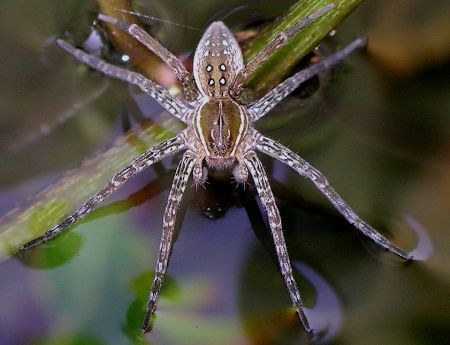
FREQUENCY: Common
NO. APPEARING: 1-10
ARMOR CLASS: 4
MOVE: 3"*12"
HIT DICE: 4+4
% IN LAIR: 70%
TREASURE TYPE: C
NO. OF ATTACKS: 1/1
DAMAGE/ATTACK: 2-8
SPECIAL ATTACKS: See text
SPECIAL DEFENSES: Nil
MAGIC RESISTANCE: Standard
INTELLIGENCE: Animal
ALIGNMENT: Neutral
SIZE: L
PSIONIC ABILITY: Nil
Attack/Defense
Modes: Nil
LEVEL/X.P. VALUE:
These two types have distinctive,
though similar, ways of
capturing their
prey. The net-throwing spider
hunts by
night with a rectangular
web of looped
silk which she throws over
her prey, en-
tangling it. Another species
of net-throw-
ing spider uses a 10x10-foot
web which
she lays on the ground and
camouflages.
She then attaches draglines
to each
corner ‘and conceals herself
above the
net, holding the ends of
the draglines
with her legs. Anything
that walks over
the net is caught up in
the web and hoist-
ed aloft to the spider.
Fishing spiders run numerous
lines up
and down from the ground
to their web
in a spreading fan shape.
The lines break
when anything runs into
them and thus
entangle the creature, allowing
the spi-
der to draw it up to her
web.
Hunters:
Crab
Spider, Daddy Longlegs, Jumping
Spider, Raft or Swamp Spider, Spitting
Spider, Trap-door or Purse Spider, Whip
Spider, Wolf Spider.
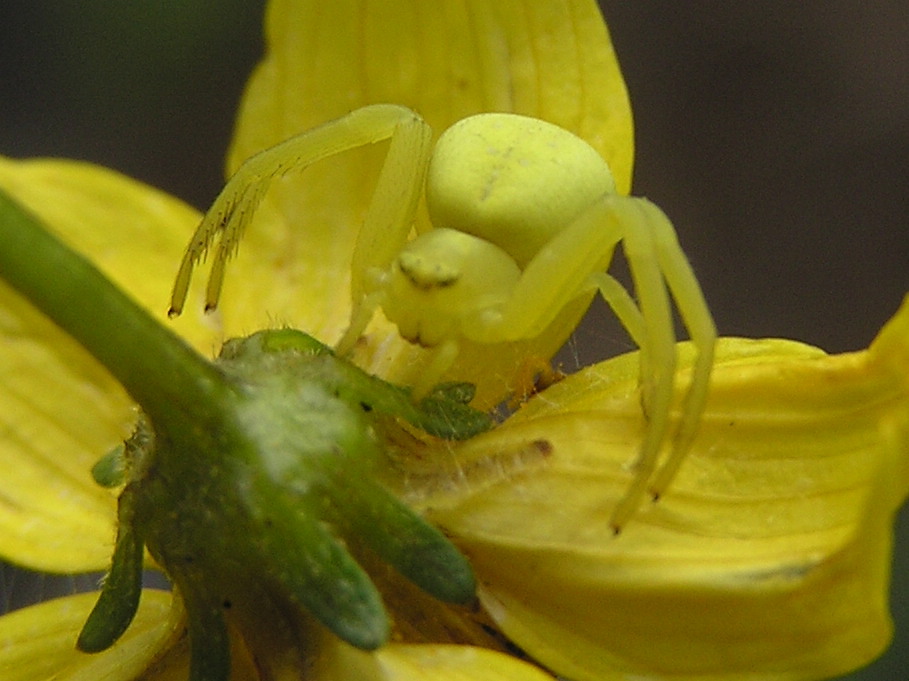
FREQUENCY: Common
NO. APPEARING: 1-10
ARMOR CLASS: 4
MOVE: 3"*12"
HIT DICE: 4+4
% IN LAIR: 70%
TREASURE TYPE: C
NO. OF ATTACKS: 1/1
DAMAGE/ATTACK: 2-8
SPECIAL ATTACKS: See text
SPECIAL DEFENSES: Nil
MAGIC RESISTANCE: Standard
INTELLIGENCE: Animal
ALIGNMENT: Neutral
SIZE: M
PSIONIC ABILITY: Nil
Attack/Defense
Modes: Nil
LEVEL/X.P. VALUE:
These spiders are so named
because
in shape they resemble a
crab and be-
cause, unlike other spiders,
they are able
to walk backwards and sideways.
They
have chameleon-like abilities
and can
change color and skin texture
to match
almost any background (glass,
crystal,
and murals excepted). They
surprise on
a roll of 1 on d4 because
of their camou-
flage ability.
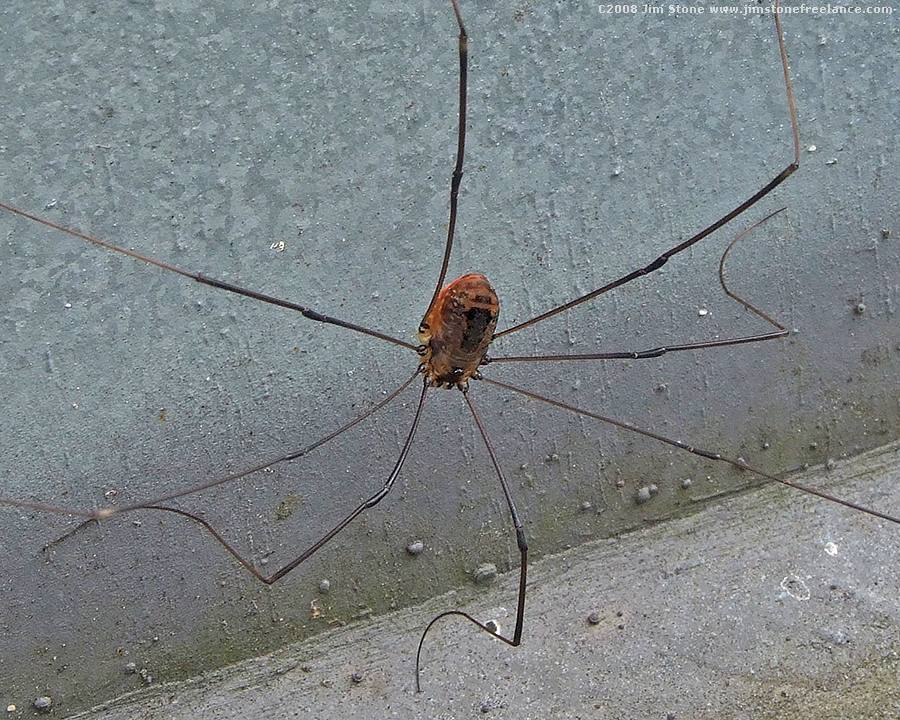
FREQUENCY: Common
NO. APPEARING: 2-15/15-25
ARMOR CLASS: 6
MOVE: 18"
HIT DICE: 2+2
% IN LAIR: 50%
TREASURE TYPE: [J], [K],
[L], [M], [N], [Q]
NO. OF ATTACKS: 1
DAMAGE/ATTACK: 1-6/3-12
SPECIAL ATTACKS: See text
SPECIAL DEFENSES: See text
MAGIC RESISTANCE: Standard
INTELLIGENCE: Animal
ALIGNMENT: Neutral
SIZE: M
PSIONIC ABILITY: Nil
Attack/Defense
Modes: Nil
LEVEL/X.P. VALUE:
This creature is an oddity,
even among
spiders, and can provide
dungeon ad-
venturers with unexpected
difficulty. The
Daddy Longlegs, also known
as the
“harvester” or “mower” spider
because
of the scythe-like action
of her legs, is
especially numerous in the
late fall of the
year during harvest.
The cephalothorax and abdomen
are
fused into one unit which
is supported
by eight extremely long,
thin legs. The
legs effectively and speedily
lift and car-
ry the body beyond the reach
of raiding
giant ants and any thrusting
sword, javel-
in, or standard spear (about
20 to 25 feet
up). A pike might reach,
but this would
require at least two strong
men to wield it
in that awkward position.
Arrows have
the standard effect.
The Daddy Longlegs is also
equipped
with a pair of glands, one
on each side of
her body, that emit a reddish,
acrid vapor
similar to that of the bombardier
beetle.
Like the bombardier beetle?
if continual-
ly disturbed or attacked,
there is a 50%
chance each round that the
spider will
lift her body to the full
extension of her
legs and fire an 8’x8’x8’
cloud of gas that
will cause 3-12 points of
damage. The
gas can be fired every third
round, but no
more than twice in an eight-hour
span.
The Daddy Longlegs will
attempt to flee
just after using her gas
attack.
In nature, the Daddy Longlegs
has one
other way to escape detection.
She can
hang from a web strand and
rotate,or
stand and vibrate, at so
fast a rate that
she becomes a near-invisible
blur. In an
AD&D adventure, characters
seeking the
Daddy Longlegs need to be
very sharp-
sighted, or of the elven
race, to detect a
“spinning” spider, and then
only if they
are looking for it.
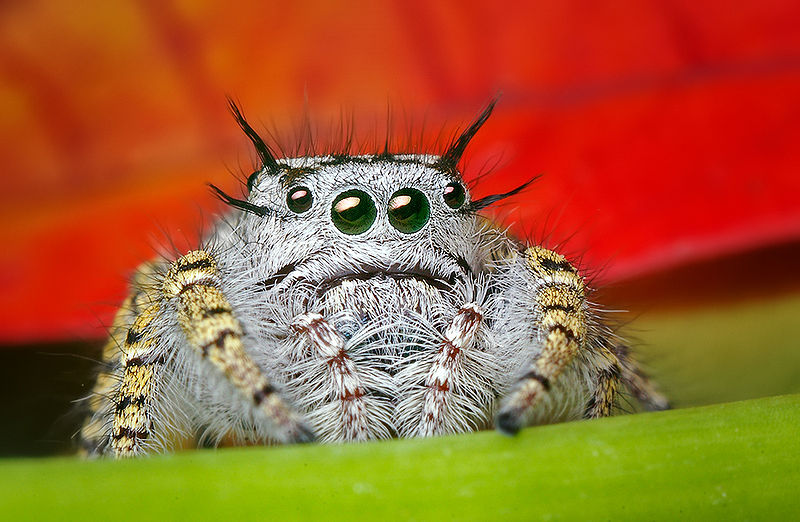
FREQUENCY: Common
NO. APPEARING: 1-12
ARMOR CLASS: 6
MOVE: 18"/40"
HIT DICE: 2+2
% IN LAIR: 50%
TREASURE TYPE: [J], [K],
[L], [M], [N], [Q]
NO. OF ATTACKS: 1/2
DAMAGE/ATTACK: 1-6/1-10
SPECIAL ATTACKS: See text
SPECIAL DEFENSES: See text
MAGIC RESISTANCE: Standard
INTELLIGENCE: Animal
ALIGNMENT: Neutral
SIZE: M
PSIONIC ABILITY: Nil
Attack/Defense
Modes: Nil
LEVEL/X.P. VALUE:
The jumping spider has very
keen eye-
sight thanks to her four
large eyes. She
stalks her prey by creeping
slowly upon
it, “freezing” whenever
it looks her way.
When “frozen,”the spider
looks very
much like a large rock.
When she has
come within range, she leaps
uponher
prey. The jumping spider
is capable of
leaps of at least 40 feet.
The spider al-
ways has a safety dragline
attached to
herself, in case the leap
does not pro-
duce the intended result.
The Dungeon Master
should determine
whether any damage results
from the
impact of the spider landing
on her vic-
tim. If the target is within
the bare limits
of the spider’s maximum
jumping range
of 40 feet, a roll of 1
on d6 indicates a
successful impact; within
30 feet, the
leap will be a “hit” on
a roll of 1 or 2 on d6;
within 20 feet, a roll of
3 or less is needed;
within 10 feet, a roll of
5 or less; and for
any distance less than 10
feet, there is an
automatic “hit” on the jump.
The dam-
age from this blow will
be 1-10 points,
perhaps modified upward
depending on
circumstances.
This spider may be found
around cliffs,
scurrying across open ground,
or in rain
forests.
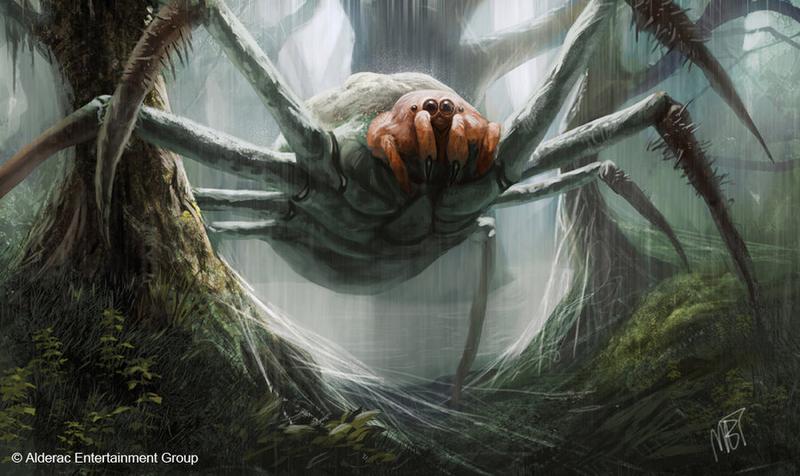
FREQUENCY: Uncommon
NO. APPEARING: 1-6
ARMOR CLASS: 6
MOVE: 18"
HIT DICE: 2+2
% IN LAIR: 50%
TREASURE TYPE: [J], [K],
[L], [M], [N], [Q]
NO. OF ATTACKS: 1
DAMAGE/ATTACK: 1-6
SPECIAL ATTACKS: See text
SPECIAL DEFENSES: See text
MAGIC RESISTANCE: Standard
INTELLIGENCE: Animal
ALIGNMENT: Neutral
SIZE: M
PSIONIC ABILITY: Nil
Attack/Defense
Modes: Nil
LEVEL/X.P. VALUE:
The raft or swamp spider
is found
along lake shores and in
marsh areas.
She makes her den by the
water’s shore
and waits for prey to appear
on or be-
neath the surface of the
water. She then
scurries across the surface
of the water,
skimming over it with the
aid of the li-
quid’s surface tension.
Trailing behind
her is a safety cable anchored
to shore
so she can pull herself
back in should
that prove necessary.
When threatened, the swamp
spider
can hide underwater by walking
down
along the side of the marsh
or on the lake
bottom. The many hairs on
her body and
legs capture and hold air
bubbles suffi-
cient for from 10 to 12
hours or more of
breathing. Also, the air
bubbles provide
buoyancy sufficient to bring
her back to
the surface when she wishes.
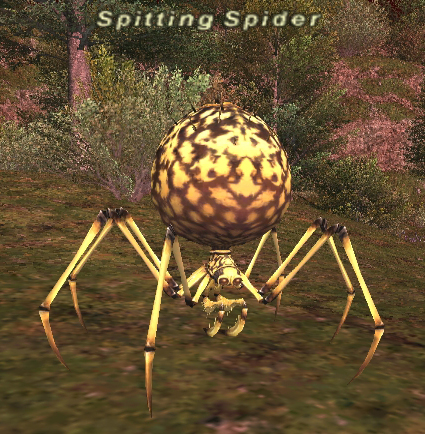
FREQUENCY: Rare
NO. APPEARING: 1-4
ARMOR CLASS: 6
MOVE: 18"
HIT DICE: 2+2
% IN LAIR: 50%
TREASURE TYPE: [J], [K],
[L], [M], [N], [Q]
NO. OF ATTACKS: 1
DAMAGE/ATTACK: 1-6
SPECIAL ATTACKS: See text
SPECIAL DEFENSES: See text
MAGIC RESISTANCE: Standard
INTELLIGENCE: Animal
ALIGNMENT: Neutral
SIZE: M
PSIONIC ABILITY: Nil
Attack/Defense
Modes: Nil
LEVEL/X.P. VALUE:
This yellow-and-black-striped
hunter
spits a blob of sticky silk
at her prey to
pin it down. The silk blob
is approximate-
ly one foot in diameter
and can be shot
15 to 20 feet. Whore other
spiders spit
silk purely as a defensive
measure, this
species has adapted it for
hunting and
thus is able to shoot a
large amount of
silk for a greater distance.
Four melee
rounds are required to recharge
the spit-
ting mechanism, up to a
maximum usage
of five shots every eight
hours.
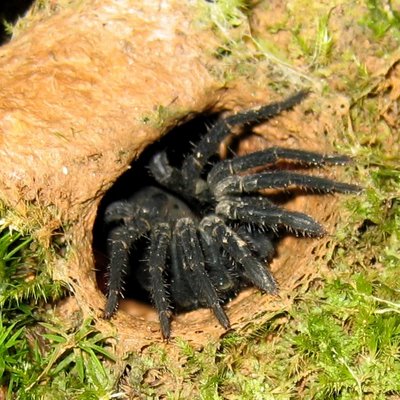
FREQUENCY: Common
NO. APPEARING: 1-12
ARMOR CLASS: 6
MOVE: 18"
HIT DICE: 2+2
% IN LAIR: 80%
TREASURE TYPE: [J], [K],
[L], [M], [N], [Q]
NO. OF ATTACKS: 1
DAMAGE/ATTACK: 1-6
SPECIAL ATTACKS: See text
SPECIAL DEFENSES: See text
MAGIC RESISTANCE: Standard
INTELLIGENCE: Animal
ALIGNMENT: Neutral
SIZE: M
PSIONIC ABILITY: Nil
Attack/Defense
Modes: Nil
LEVEL/X.P. VALUE:
IUCN: Cyclocosmia torreya = DD
This nocturnal huntress uses
her fangs
to dig a tunnel in soft
or sandy soil. The
burrow runs down for nearly
50 feet with
an emergency side tunnel
hidden by a
camouflaged door about halfway
down.
The burrow’s diameter is
just a little bit
larger than that of the spider’s
body. The
walls of the burrow are
lined with a “ce-
ment” mixed from dirt, silk,
and spider
saliva, then coated with
silk.
There are two types of trap-door
spi-
ders. The first. constructs
an actual trap
door, about an inch or two
thick, of alter-
nating layers of silk and
earth, hinged
with silk and camouflaged
with earth,
moss, leaves, branches,
and so forth at-
tached to a layer of sticky
silk.
Some trap-door spiders leave
the bur-
row at night to lay snares
of sticky silk on
the ground. During the night,
chances
are that something will
walk onto the
snare and get stuck. Come
the dawn, the
spider re-emerges from her
burrow,
picks up the traps and goes
home. Other
spiders may remain in the
burrow and lift
the trap-door lid a crack
to watch what
goes by. When the spider
sees some-
thing worth grabbing, she
rushes out
and pounces on it, bites
it to paralyze it,
then drags it home.
The door to the burrow is
camou-
flaged so well that only
very close obser-
vation will detect the vague
horseshoe-
shaped outline of the tunnel
door, and
then only if the character
knows what he
or she is looking for. When
the spider
retreats to hide in the
burrow, she holds
the door shut with, her
feet and fangs,
and only an individual with
strength of 18
or better (normal or magically
enhanced)
will be able to open the
door — which, of
course, leaves him or her
immediately
vulnerable to the attack
of the spider
waiting just inside the
door.
DMs should also note that
gauntlets of
ogre power impart a strength
of 18 only
to the hands, arms, and
shoulders of the
user, not to the back and
remainder of
the body, so that the use
of this magical
item alone is not sufficient
to lift the trap-
door lid. It must be supplemented
by, for
instance, a girdle or potion
of giant
strength.
The second type of trap-door
spider
does not make an actual
trap door. In-
stead, she leaves three
feet or more of
hollow silk tubing, camouflaged,
lying
above the ground. The tubing
is sealed,
and the spider crouches
below it, waiting
for something to land on
or run across
the tubing. The spider then
strikes with
her fangs through the web
and paralyzes
the creature. She cuts a
hole in the web-
bing to drag her prey through,
repairs
the hole, and goes below
to eat.
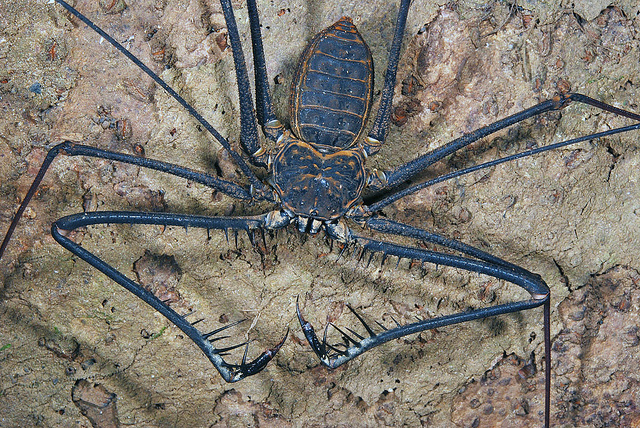
FREQUENCY: Rare
NO. APPEARING: 1-4
ARMOR CLASS: 6
MOVE: 18"
HIT DICE: 2+2
% IN LAIR: 50%
TREASURE TYPE: [J], [K],
[L], [M], [N], [Q]
NO. OF ATTACKS: 2/1
DAMAGE/ATTACK: 1-3/1-3/1-6
SPECIAL ATTACKS: See text
SPECIAL DEFENSES: See text
MAGIC RESISTANCE: Standard
INTELLIGENCE: Animal
ALIGNMENT: Neutral
SIZE: M
PSIONIC ABILITY: Nil
Attack/Defense
Modes: Nil
LEVEL/X.P. VALUE:
The whip spider, in nature,
has a flat-
tened body with the first
pair of legs
developed beyond their normal
length
so that they resemble whips,
though
they are used only as feelers,
like an in-
sect’s antennae.
The whip spider, in AD&D
terms, has
10-foot-long front legs
that can be used
like whips to either attack,
or catch and
hold, prey. The “whips”
cause 1-4 points
of damage each on an attack;
if both
whips score hits, the spider
has made a
“grab” and will draw the
attacker toward
her chelicerae and fangs.
Occasionally,
the whips will ensnare one
or both of the
victim’s arms, making self-defense
diffi-
cult if not impossible;
roll d6 for each
arm after a “grab” is made,
with a roll of 1
indicating that the arm
has been caught.
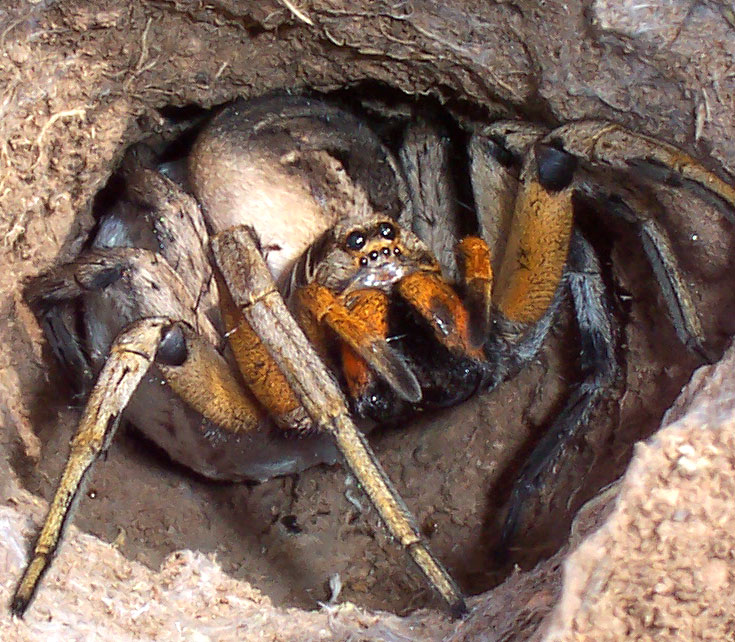
FREQUENCY: Common
NO. APPEARING: 1-12
ARMOR CLASS: 6
MOVE: 18"
HIT DICE: 2+2
% IN LAIR: 50%
TREASURE TYPE: [J], [K],
[L], [M], [N], [Q]
NO. OF ATTACKS: 1
DAMAGE/ATTACK: 1-6
SPECIAL ATTACKS: See text
SPECIAL DEFENSES: See text
MAGIC RESISTANCE: Standard
INTELLIGENCE: Animal
ALIGNMENT: Neutral
SIZE: M
PSIONIC ABILITY: Nil
Attack/Defense
Modes: Nil
LEVEL/X.P. VALUE:
The wolf spider, like the
trap-door
spider, lives in a silk-lined
burrow, but
without the door. She tracks
prey by
sight and by special scent-detecting
or-
gans located in the pedipalps.
When she
sees prey, she sprints after
it, captures it,
and paralyzes it before
returning to her
den.
She is very protective of
her young,
carrying the cocoon under
her belly
wherever she goes and fighting
fiercely
for her young. When hatched,
wolf spi-
derlings number from 100-200,
and will
ride on the mother’s back
until they are
full grown. If the mother
encounters an-
other female wolf spider,
she will stop
and let her young get off,
and then she
will fight the other spider
to the death.
The survivor will adopt
the spiderlings of
the dead mother.